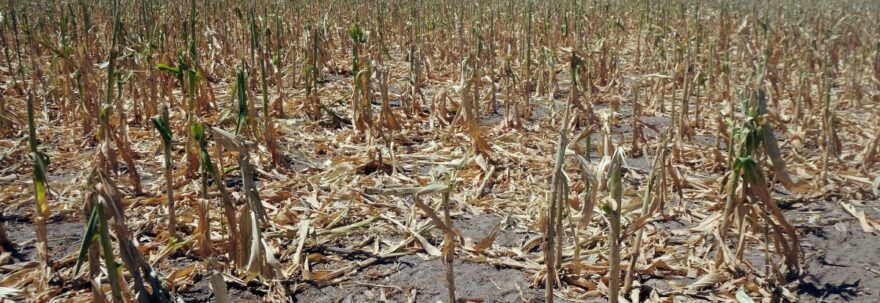Pests and the decrease in pastures, the great enemies of agriculture and livestock in a scenario marked by global warming and reduced rainfall.
The increase in temperatures as a direct consequence of greenhouse gas emissions has begun to have a direct negative impact on plant and animal species in Spain. Although there is still no evidence of the disappearance of any crop, scientists have begun to warn about the multiplication of pests that devastate the fields, which will also affect animals.
Agriculture and livestock in Spain employ 5% of the active population. However, if all associated activities are taken into account, the agri-food industry, transport and distribution contribute 14.2% to employment and 10.6% to GDP. Spain is the second country in the EU in area and agricultural production, with an annual production of 25,357 million euros, which represents 13% of European production.
Agriculture directly suffers the effects of climate change and also the impacts of increased soil erosion, floods and droughts, as well as the increase in pests and diseases. Excessively high temperatures during the flowering and grain development period (approximately mid-April to mid-July) can influence the yield of arable crops.
According to the report ‘Impacts and Risks Derived from Climate Change in Spain, 2021’ from the Ministry for Ecological Transition, it is estimated that days with temperatures above 25° (threshold from which yields may decrease) will increase in the next 30 years. This will increase the water needs of crops, which, together with a decrease in rainfall, will cause, for example, a decrease in the number of optimal areas for growing cereals.
Less water means less production.
In rainfed agriculture, the impacts of warmer temperatures and less rainfall depend on the type of crop. Thus, it is expected that in the short term (2030), rainfed summer crops (mainly maize, beetroot and sunflower) in the southern European regions will suffer the greatest impacts. For example, in some areas of Galicia, the production losses of corn and sugar beet can reach 50%.
Irrigation represents 65% of the total water demand. In simulations where water is not a limiting factor, the decrease in the production of the main irrigated crops would be mainly due to high temperatures and would be around 20%, much less than in rainfed conditions.
If there were no other limiting factor (water, soil nutrients, organic matter), the higher concentration of CO2 compared to current levels would have a fertilizing effect that could offset other impacts. However, drought episodes do affect the amount of water that farmers receive, which may be insufficient to meet the demands of the crops, which translates into a decrease in yields and its effects on profitability.
During the second half of the 20th century, a reduction of between 10% and 20% of the available water resources was detected in many basins of the peninsula. In some of them (Duero, Guadalquivir, Guadiana and Júcar), the average rainfall decreased between 2% and 8% in the last six decades, while in others, such as the Ebro and inland basins of Catalonia, this reduction was not significant. This trend of decreasing available water is expected to continue throughout this century.
Due to the decrease in rainfall, yields are expected to decrease by 3.5% and 7% for irrigated and rainfed olive groves, respectively, in the period 2030-2050 compared to the period 1980-2009.
Between 2080 and 2100, the reduction would be even greater, at 11% and 23%, respectively. This same decrease in rainfall will limit the possibility of installing irrigation systems as a measure to deal with the effects of climate change, according to the study by the Ministry.
Therefore, irrigation communities and basin management agencies must be empowered to develop collective water management strategies.
The impacts of this climatic change, for example in the vineyards, depend on the growth period of the plant. Although the increase in winter average temperatures can be beneficial by reducing the risk of frost, in summer, during the ripening period, there is a risk of a decrease in quality (lower acidity, color and tannins) and an increase in content. . alcoholic.
This is because, with earlier higher temperatures, especially with a decrease in the day/night temperature differential, the pulp precipitously reaches a high sugar concentration, while the skins and seeds mature more slowly. Thus, if the grape is harvested at its optimal sugar level, it may not have the desired aroma or color, but if you wait for aromatic maturity, you run the risk of excessive alcohol content.
On the other hand, the advance of spring temperatures causes advances in flowering in temperate climate fruit trees, which on average in Europe have advanced 2.5 days per decade since the 1970s. However, in stone fruit trees grown in warmer climates, in hot seasons, not having enough dormant chill hours can lead to the opposite dynamic, namely delayed flowering. Also, flowering is irregular and more likely to fail.
Many of these fruit trees (almond, apricot, cherry) have hermaphroditic flowers whose male and female parts mature at different rates. Traditionally, farmers have solved this mismatch by combining rows of different varieties, such as almonds, with the help of pollinating fauna.
The trend towards delayed flowering and decoupling of plant-insect interactions has been observed over the last 40 years, so the current timing of pollination is likely to change.
This can cause reductions in production, but above all, a mismatch in planning, which can make harvesting and marketing the fruit unfeasible. The consequence at a European level is that there will be more optimal territories for the cultivation of cherries and other stone fruits restricted by low temperatures, and this would mean the loss of Spain’s comparative advantage.
Regarding the effects of climate change on extensive livestock farming, the increase in temperatures causes thermal stress in animals, which has a series of negative repercussions. These include reduced growth and production, reduced reproductive rates, and higher mortality rates.
Thermal stress also reduces the resistance of animals to pathogens, parasites and vectors, since the increase in temperatures favors their winter survival, according to a recent report by the Extensive Livestock and Grazing Platform.
Thus, “multiple stress factors significantly affect the production, reproduction, and immune status of animals,” according to this study.
In addition, the increasing variability of rainfall causes a shortage of drinking water, as well as an increase in the incidence of pests and diseases of livestock and changes in their distribution and transmission. It also affects the plant species that make up the pastures, their yields and the quality of the forage.
There are studies based on the experiences of the farmers themselves. From a sample of 100 professionals in the Spanish extensive livestock sector, 78% report an increase in dry periods (less rainfall in summer and spring), 73% report seasonal changes, 70% report a decrease in water flow in bodies of water, and 69% report increases at maximum temperatures.
To face the new climate scenario, the Extensive Livestock Platform is committed to grazing as the best tool, as it has always been done: “Pastoring, being mobile, allows you to get away from imminent climatic disasters, such as droughts or heat.” waves, seeking refuge in areas with better conditions. It also makes it possible to manage the availability of food by moving animals in search of optimal grazing conditions and ensuring rest periods for pastures.
In addition to recalling the advantages of native breeds, the same report states that extensive livestock farming has other advantages over intensive farming: “In addition to the possibility of displacement, there is the possibility of quickly readjusting the size of the herd to prevent risk situations. . For example, in a prolonged drought, animals can be sold, herd size can be reduced, and the need to purchase feed for the remaining animals can be addressed. In a better season, increase the number of replacement animals to increase the herd and take advantage of the abundance.”
Both the Ministry and the livestock and agricultural groups highlight the need for a general adaptation to the new situation to maintain the profitability of farms.



